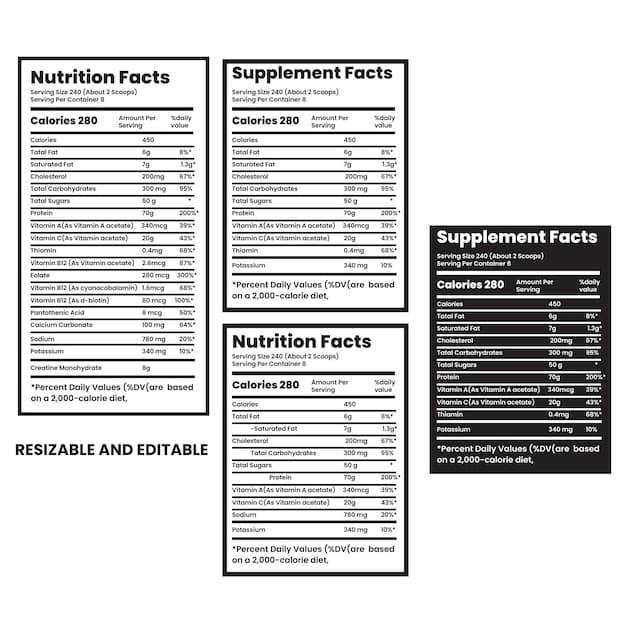How to Read Anti-Aging Supplement Labels: Avoid Mistakes

Knowing **how to read anti-aging supplement labels** is crucial to avoid common mistakes like overlooking hidden ingredients, ignoring dosage instructions, and falling for misleading marketing claims, ensuring you make informed and safe choices.
Navigating the world of anti-aging supplements can feel like deciphering a foreign language. This guide will show you **how to read anti-aging supplement labels** effectively to avoid the most common pitfalls and ensure you’re making informed choices for your health and longevity.
Understanding the Basics of Supplement Labels
Before diving into the common mistakes, it’s essential to understand the basic components of a supplement label. Knowing what each section means is the first step in **how to read anti-aging supplement labels** intelligently.
Supplement labels are governed by regulations that require manufacturers to list specific information, but interpreting this information can still be tricky.
Key Components of a Supplement Label
A typical supplement label includes several key sections that provide essential information about the product.
- Supplement Facts Panel: This panel lists the active ingredients, serving size, and the amount of each nutrient per serving. It’s similar to the Nutrition Facts panel on food labels.
- Ingredient List: This section lists all ingredients, both active and inactive, in descending order by weight.
- Manufacturer Information: The label includes the name and address of the manufacturer or distributor.
- Dosage Instructions: This section provides instructions on how to take the supplement, including the recommended serving size and frequency.
Understanding these components is crucial for making informed decisions about anti-aging supplements.
Mistake #1: Overlooking Hidden Ingredients and Fillers

One of the most common mistakes people make when trying to know **how to read anti-aging supplement labels** is overlooking the hidden ingredients and fillers. These inactive ingredients can have a significant impact on the supplement’s effectiveness and safety.
Many supplements contain fillers, binders, and artificial additives that don’t contribute to the anti-aging benefits and may even cause adverse reactions.
The Impact of Fillers and Additives
Fillers are often used to add bulk to the supplement, while binders help hold the ingredients together. Artificial additives are used to improve the supplement’s appearance, taste, or shelf life.
- Allergic Reactions: Some fillers and additives can trigger allergic reactions in sensitive individuals.
- Digestive Issues: Certain ingredients, such as artificial sweeteners, can cause digestive discomfort.
- Reduced Effectiveness: Fillers may interfere with the absorption of active ingredients, reducing the supplement’s effectiveness.
Being aware of these potential impacts can help you make better choices when selecting anti-aging supplements.
How to Identify Hidden Ingredients
Identifying hidden ingredients requires a careful examination of the ingredient list. Look for ingredients that you don’t recognize or that seem unnecessary.
Some common fillers and additives to watch out for include:
- Magnesium Stearate: A common lubricant that can sometimes cause digestive issues.
- Titanium Dioxide: A pigment used to whiten supplements, with potential health concerns.
- Artificial Colors and Flavors: Additives that may cause allergic reactions or sensitivities.
By being vigilant and researching unfamiliar ingredients, you can avoid supplements with potentially harmful additives.
Carefully reviewing the entire ingredient list, not just the Supplement Facts panel, is crucial. This comprehensive approach ensures you’re fully aware of everything you’re putting into your body. Choosing supplements with minimal or no fillers can help reduce the risk of adverse effects and ensure you’re only consuming ingredients intended for anti-aging benefits.
Mistake #2: Ignoring Dosage Instructions and Serving Size
Understanding **how to read anti-aging supplement labels** correctly also involves paying close attention to the dosage instructions and serving size. Ignoring these guidelines can lead to ineffective results or, worse, adverse health effects.
The correct dosage is essential for achieving the desired benefits without risking your well-being.
The Importance of Correct Dosage
Taking too little of a supplement may not provide any noticeable benefits, while taking too much can lead to side effects or even toxicity.
Always follow the dosage instructions provided on the label, and consult with a healthcare professional if you have any questions or concerns.
Factors like age, weight, and overall health can influence the ideal dosage, so personalized guidance is often beneficial.
Misinterpreting Serving Size
Serving size refers to the amount of the supplement that constitutes one dose. It’s important to understand the serving size and adjust your intake accordingly.
- Multiple Servings: Some supplements require multiple servings per day, which can be easy to overlook.
- Concentrated Formulas: Certain supplements are highly concentrated, requiring only a small serving size.
Be mindful of these factors to ensure you’re taking the correct amount of the supplement.
Reading and adhering to dosage instructions is vital. Individual needs vary, so consider consulting a healthcare professional to tailor supplement usage to your specific health profile. This ensures both safety and efficacy in your anti-aging regimen.
Mistake #3: Falling for Misleading Marketing Claims

The third major mistake when learning **how to read anti-aging supplement labels** is falling for misleading marketing claims. The supplement industry is rife with hype and exaggeration, making it crucial to approach labels with a critical eye.
Spotting these deceptive tactics can save you money and protect your health.
Common Misleading Claims
Many supplements make bold claims about their anti-aging benefits, but these claims are often unsubstantiated and misleading.
Claims to watch out For:
- Miracle Cures: Claims that a supplement can cure or reverse aging are usually too good to be true.
- Guaranteed Results: Supplements that guarantee 100% results are likely exaggerating their effectiveness.
- Celebrity Endorsements: Endorsements from celebrities don’t necessarily indicate the supplement’s quality or effectiveness.
How to Evaluate Marketing Claims
To avoid being misled, it’s important to evaluate marketing claims critically.
- Look for Scientific Evidence: Check whether the claims are supported by scientific research or clinical trials.
- Read Reviews: Look for unbiased reviews from reputable sources or healthcare professionals.
- Consult with a Healthcare Provider: Discuss the supplement with a doctor or registered dietitian to get their expert opinion.
By doing your research and seeking professional advice, you can make informed decisions about which anti-aging supplements are worth trying.
Critical evaluation of marketing claims is a key skill. Don’t rely solely on advertising; seek scientific validation and professional opinions. This approach will help you make informed decisions and choose anti-aging supplements that are both safe and effective for your needs.
Additional Tips for Reading Supplement Labels
Beyond avoiding the common mistakes, there are several additional tips that can help you become a savvy supplement label reader. These tips will enhance your ability to make well-informed decisions about your anti-aging supplement choices.
Knowing these additional elements can further protect your health and ensure you’re using supplements wisely.
Check for Third-Party Certifications
Third-party certifications indicate that a supplement has been independently tested for quality, purity, and potency. Look for certifications from reputable organizations such as:
These certifications can provide assurance that the supplement contains what it claims and is free from contaminants.
- NSF International: Certifies that the supplement has been tested for contaminants and meets quality standards.
- USP Verified: Ensures that the supplement contains the ingredients listed on the label in the stated amounts and meets purity standards.
- Informed-Choice: Tests supplements for banned substances, making it a valuable certification for athletes.
Understand Expiration Dates
Ensure your supplements are safe and effective by paying attention to expiration dates, so use them before they expire.
Pay Attention to Warnings
Warnings on labels can alert you to potential side effects, interactions with medications, or contraindications for certain health conditions. Heed any warnings provided and consult with a healthcare professional if needed.
Following these additional tips will enhance your understanding of supplement labels and help you make safer, more effective choices.
Adhering to these additional guidelines enhances your understanding and ensures you can make informed decisions. By staying informed and proactive, you can confidently navigate the world of anti-aging supplements, ensuring your choices align with your health goals.
The Role of a Healthcare Professional
While knowing **how to read anti-aging supplement labels** is essential, consulting with a healthcare professional remains crucial. Doctors, registered dietitians, and other healthcare providers can offer personalized advice based on your unique health needs and goals.
Healthcare professionals can provide personalized recommendations, monitor your progress, and help you avoid potential risks.
Personalized Recommendations
Consulting with a healthcare professional can help you avoid general advice and get personalized recomendations.
The healthcare professional can also take into account any other medication you are taking and give appropriate advice if you have any health condition.
Healthcare professionals are also aware of recent supplement research and can give up to date information.
Monitoring Progress and Safety
Healthcare professionals can monitor your health and adjust your supplement regimen accordingly, ensuring you achieve the desired results safely.
A healthcare professional can identify any changes in your body due to the supplements and can advise you if you need to reduce or increase the dose.
Managing Potential Risks
Healthcare professionals are trained to identify and manage potential risks associated with supplement use, such as interactions with medications or adverse effects.
Whenever you are taking a new supplement, make sure you advise your health care professional and keep them informed of how you are feeling.
Incorporating the expertise of healthcare professionals into your strategy ensures a safe and effective approach. This collaborative method empowers you to make well-informed decisions, maximizing the benefits of anti-aging supplements while minimizing potential risks.
| Key Point | Brief Description |
|---|---|
| ⚠️ Hidden Ingredients | Watch out for fillers and additives that can cause adverse reactions. |
| 📏 Dosage | Adhere to dosage instructions to avoid ineffectiveness or side effects. |
| 🧐 Marketing Claims | Evaluate claims critically, seeking scientific evidence and expert opinions. |
| ✔️ Third-Party Certifications | Look for certifications to ensure quality and purity. |
FAQ
▼
The Supplement Facts panel is a section on the label that lists the active ingredients, serving size, and the amount of each nutrient per serving, similar to the Nutrition Facts panel on food labels. It’s a crucial tool for understanding what you’re consuming.
▼
Fillers are added to supplements to increase the bulk of the product, aid in manufacturing, or improve the product’s texture and appearance. However, some fillers can cause adverse reactions or reduce the effectiveness of the active ingredients.
▼
Recognize misleading claims by being skeptical of miracle cures, guaranteed results, and celebrity endorsements. Always look for scientific evidence and consult with healthcare professionals to verify the supplement’s benefits before making a purchase.
▼
Third-party certifications indicate that a supplement has been independently tested for quality, purity, and potency by an organization like NSF International or USP Verified. These certifications provide assurance that the product meets specific standards.
▼
Following dosage instructions is crucial to avoid ineffective results or adverse health effects. Taking too little may not provide any benefits, while taking too much can lead to side effects or toxicity. Always adhere to the recommended serving size on the label.
Conclusion
Mastering **how to read anti-aging supplement labels** empowers you to make informed, safe choices. By avoiding common mistakes like overlooking hidden ingredients, ignoring dosage instructions, and falling for misleading claims, you can select supplements that genuinely support your health goals and enhance your well-being.





